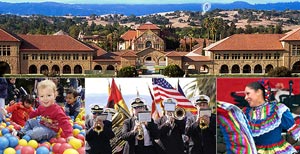

Thursday - April 12, 2007
SLAC Today is
available online at:
http://today.slac.stanford.edu
In this issue:
Come Represent SLAC at Stanford's Community Day
Science Today: Taming a Potent Toxin
Barry's Bay to BaBar: The Evolution of a Physicist
MiniBooNE Opens the Box
 |
 |
|
Thursday - April 12, 2007 |
Come Represent SLAC at Stanford's Community Day This Sunday, from 10:00 a.m. to 4:00 p.m., SLAC will participate in Stanford's Community Day, a family-oriented university "open house." All are encouraged to come out for the event—there will be countless avenues for Sunday fun and entertainment including tours of the Jasper Ridge Biological Preserve, art exhibits, musical performances, faculty lectures and pony rides. And, of course, there is the SLAC booth! SLAC's station, located in front of the D. Packard Electrical Engineering Building, will offer rewards to those who can stump lab researchers with questions about the universe. Kids will be able to count cosmic rays while eating liquid nitrogen ice cream, and visitors will be able to view a special screening of footage on the science and culture of the laboratory. The short film will include stunning visualizations of the universe, images from numerous ongoing experiments at SLAC, as well as footage from Kids' Day and other special lab-wide events. Your enthusiasm and your support are needed to inject festivity into Community Day! Come out and represent the laboratory at this very special outreach event. For more information or to volunteer, please contact Melinda Lee at x8547. |
||
|
|
||
 Taming a Potent Toxin
Botulinum neurotoxin is produced by the bacteria Clostridium botulinum and is the most potent toxin known, inducing a potentially fatal paralysis known as botulism. Botulism can occur in a number of ways, including infection through open wounds or in the intestinal tract, or after consuming contaminated food in which toxin has been produced. In the USA, infant botulism is the most common manifestation of the disease—some speculate whether its prevalence is linked to sudden infant death syndrome. On the other hand, these neurotoxins have also become a powerful therapeutic tool for treating a variety of neurological, ophthalmic, and other disorders manifested by abnormal, excessive, or inappropriate muscle contractions. In a recent series of x-ray crystallography studies conducted in part at SSRL, two research groups have determined the mechanism by which the botulinum neurotoxin binds to nerve receptors and causes infection, a finding that could lead to new preventive and therapeutic treatments. The work is published in the December 13, 2006, issue of Nature. In one study, researchers from a collaboration led by The Scripps Research Institute looked at the structures of botulinum toxin in complex with a neuronal cell surface receptor and botulinum toxin with two different neutralizing antibodies, each to a resolution of 2.6 Å. The group also performed biochemical, mutagenesis, and neurobiology experiments to complement the structural work. The interdisciplinary research projects provide insight into the atomic details on the intoxication process, and the means by which antibodies neutralize the effects of botulinum neurotoxin. These structures open the possibility of developing improved broad-spectrum therapeutics, including antibodies, small molecule drugs and vaccines against the toxin. In an adjoining study published in the same issue of Nature, Axel Brunger's group at Stanford University determined the first crystal structure of a botulinum neurotoxin in complex with its protein receptor to a resolution of 2.15 Å. The results could lead to development of preventive vaccines or inhibitors against these neurotoxins. Additionally, owing to the specific geometry of the binding mechanism, this study suggests that appropriately modified botulinum neurotoxins could also be used as drug delivery systems. |
Barry's Bay to BaBar: Evolution of a Physicist
As a child growing up in Canada, Patricia Burchat never imagined herself as a professor of physics, let alone one at Stanford. "Back then I didn't even know what physics was exactly," said Burchat, the university's Gabilan Professor. But today, as one of the founders of the BaBar project at SLAC, conducting research about fundamental questions in physics and cosmology, she is a long way from Barry's Bay, the small logging and farming community in Ontario that was her childhood home. Read more... MiniBooNE
|
Events (see all | submit)
Access (see all)Announcements
|
| | ||
|
|
||
 <%
Response.AddHeader "Last-modified", getArticleDate()
'Response.AddHeader "Last-modified","Mon, 01 Sep 1997 01:03:33 GMT"
'Monday, December 06, 2010
%>
<%
Response.AddHeader "Last-modified", getArticleDate()
'Response.AddHeader "Last-modified","Mon, 01 Sep 1997 01:03:33 GMT"
'Monday, December 06, 2010
%>View online at http://today.slac.stanford.edu/. |
||